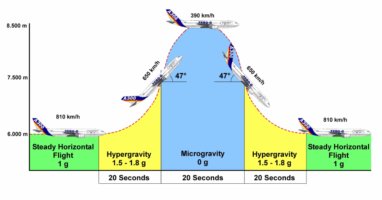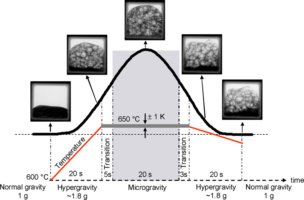ESA Parabolic Flight Campaign

|
In November 16 I had the final cooperation project with my research group of the Technical University Berlin and Metalfoam group under the guidance of
Francisco Garcia-Moreno. This was a unique and maybe once in a life experience for me to be part of a scientific micgrogravity campaign. In the following you
will find original description of the the background, objectives and results of the 65th parabolic flight campaigne.
For further details see:
ESA Parabolic Flights
History
µg-FOAM MAP started in 2000 and focused until present on the development of an ambitious program of microgravity related experiments. A follow up project based on the proposed in-situ X-ray diagnostic system was the XRMON MAP, which focuses on in-situ experimental investigations of fundamentals in solidification of metal and important phenomena in the fields of materials processing. Ability to study under microgravity conditions will constitute a very important supplement to present material research in material science. The metallic foam experiment was selected to fly in November 2007 in the 46th ESA PFC, in April 2008 on Maser 11 and in November 2009 in the 51st ESA PFC in the frame of XRMON. Now the activities are supported by the ESA ?g-FOAM MAP project.Metal foams are a class of new materials that are already used for applications. To improve their structure and properties we have to understand their production, which takes place in the liquid phase. Liquid metallic foams are complex fluids particularly poorly understood if the liquid fraction is high. X-ray analysis was found to be a very powerful method for the in-situ study of the foaming process on Earth and under Microgravity.

|

|
Objectives
Under microgravity it is possible to isolate some of the key effects which govern foam evolution, namely drainage, flow, coarsening and coalescence. Moreover, it follows an unified approach in which solidification phenomena of metals can be investigated in a consistent manner. During the 46th ESA PFC campaign we studied foams made from precursors following the powder metallurgical route. In the second campaign, 51st ESA PFC, we concentrated in the other important production route, the so called melt route. For that purpose we prepared precursors starting from a melt and containing different amounts and types of stabilising particles like SiC or TiB2 and viscosity-enhancing additives. With the manipulation of the amount and type of stabilising particles we could study more in detail their influence on drainage and viscosity than could be done by the oxide stabilised samples done previously.For this third campaign we procured a high-speed flat panel detector with which we will be able to provide up to 3 times more detailed data of the liquid fraction distribution curves and their transition between 0 g and 1.8 g, and therefore obtain better results of the effective viscosity and surface tension than in previous campaigns. We will study additionally the new developed metal foams without blowing agent, aiming to have a very stable foam in the liquid state at 0 g. Furthermore we will study also the imbibition force of the foam to suck a liquid melt even at 1.8 g, comparing them before and after the 1.8 g to 0 g transition.
Experiment Description
The purpose of the experiment is to observe the foaming process of an aluminium alloy under microgravity in a thermally well controlled furnace. The experiment container includes an X-ray subsystem and an experiment furnace with a small crucible, in which an Al-alloy sample is melted and foamed. The sample contains up to 0.5 wt% of TiH2, which provides the gas the foaming process. The furnace temperature is controlled during the heating, foaming and solidification process. It is heated by a coil of resistive wire and is cooled by a forced air-flow in order to e.g. to cool rapidly the system for furnace exchange or to solidify the sample before the end of microgravity. The diagnostic X-ray system consists of a micro focus X-ray source, a CMOS high-resolution digital X-ray detector and an image acquisition computer.F. García-Moreno et al., Colloids and Surfaces A: Physicochem. Eng. Aspects 344:101-106a, 2009
Conclusions of first successful microgravity experiments on liquid Al foam with in situ X-ray diagnostics
- In ground-based foaming experiments with either parallel and anti-parallel orientation of gravity and foaming direction, a 25% increase of the foaming velocity for parallel orientation (‘-1 g’) was observed.
- Strong drainage at 1.8 g was found, followed by complete imbibition of drained liquid metal into the foam after the onset of microgravity, the rate of both points at a highly mobile liquid.
- Imbibition leads to more uniform density, pore size and shape distributions and to a average liquid fractions around 40%.
- Strong and fast liquid flow during transition from 0 g to 1.8 was observed.
- Vertical liquid fraction profiles for free drainage under varying gravity conditions resemble those of aqueous foams qualitatively.

TU Berlin flight and research team
|
A little fun between working parabola
|
Results of the 65th Parabolic flight campaign acquired successfully:
Pictures and a further elaborated results coming soon…




